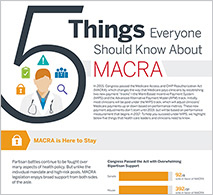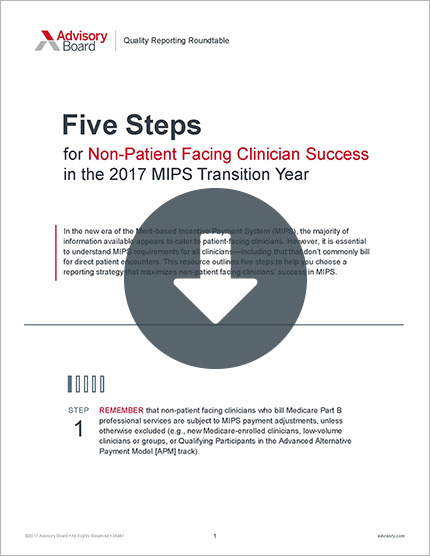Auto logout in seconds.
Continue LogoutEditor's note: This story was updated on January 30, 2019
By José Vasquez, Staff Writer
First, read the Daily Briefing's in-depth explainer. Then, sign up for tomorrow's webconference, where Advisory Board's Naomi Levinthal provides a primer on how MACRA impacts provider payments.
Register for the Webconference
If you've followed the twists and turns in Medicare's latest changes to provider payments, you know that news coverage tends to devolve into alphabet soup: "CMS in November 2018 released a final rule for MACRA's QPP in 2019, with details on the MIPS and Advanced APM tracks."
To clear up the confusion, let's revisit the fundamentals of MACRA: How did it come to be? Who does it apply to? What does it aim to accomplish? How will it affect the health care industry going forward? Daily Briefing takes a deeper look.
MACRA: The origin story
The Medicare Access and CHIP Reauthorization Act (MACRA) was born from a bipartisan effort to overhaul the way Medicare pays so-called "eligible clinicians" who bill under Medicare Part B.

5 things everyone should know about MACRA
MACRA, which passed Congress in 2015 with strong bipartisan support, permanently repealed the sustainable growth rate (SGR) formula—a rule that Congress created in the 1990s to try to rein in Medicare's spending growth, that lawmakers regularly stopped from taking effect over concerns that it would significantly cut doctors' Medicare payments. To replace the SGR, Congress passed MACRA and created the Quality Payment Program, or QPP. The goal was twofold: to enact a more realistic vision for Medicare's future payments, and to accelerate the shift away from the traditional fee-for-service model and toward value-based payments.
How does QPP work?
So how does Medicare pay for eligible clinicians' work under QPP? In short, it provides two tracks for adjusting eligible clinicians' payments under the physician fee schedule based on the quality and value of care provided. The two payment tracks are:
- The Merit-based Incentive Payment System (MIPS) track, for providers who are reimbursed largely through fee-for-service; and
- The Advanced Alternative Payment Model (Advanced APM) track, for providers who take on a significant portfolio of Advanced APMs, which include risk-based accountable care organization models.
QPP officially kicked off in 2017—but CMS called that first program year a "transition" year, giving providers more flexibility on when they must begin collecting performance data. CMS will continue to apply certain transition year policies through 2021 to help providers ease into the program.
Who is eligible to participate in QPP?
QPP generally applies to all providers who bill Medicare Part B, but each payment track has its own eligibility requirements.
Five types of clinicians were eligible to participate in MIPS for the 2017 and 2018 performance years: certified registered nurse anesthetists, clinical nurse specialists, nurse practitioners, physicians, and physician assistants. For 2019, CMS expanded the types of clinicians eligible to participate in MIPS to include physical therapists, occupational therapists, clinical psychologists, and registered dietitians or nutrition professionals.
CMS also updated its eligibility requirements for MIPS. To be eligible in 2018, physicians and practitioners had to treat at least 200 Medicare beneficiaries and submit at least $90,000 in Medicare Part B claims. Eligible clinicians in their first year as a Medicare Part B provider are not required to participate in MIPS. For 2019, CMS added an additional eligibility threshold for providers who do not submit at least 200 claims for the covered professional services under the Physician Fee Schedule. Beginning this year, CMS also is allowing clinicians or groups who meet some but not all of these eligibility thresholds to opt into MIPS.
The Advanced APM track is open to additional provider types beyond those eligible for MIPS, including certified nurse-midwives, clinical social workers, qualified speech-language pathologists, and qualified audiologists. But to qualify for the Advanced APM track in 2019, providers must have at least 50% of their Medicare patients (up from 20% in 2018) or 35% of their Medicare payments (up from 25% in 2018) billed through an Advanced APM (as determined by CMS).
The chart below shows how the eligibility threshold for Advanced APMs is expected to change in future program years:
For 2019—QPP's third program year—CMS has estimated 798,000 health care professionals will be subject to MIPS and that between 165,000 and 220,000 health care professionals will be eligible for the Advanced APM track.
The MIPS and Advanced APM tracks, explained
The MIPS Track
Physicians' pay in the MIPS track largely follows a traditional fee-for-service structure—but CMS adjusts eligible professionals' pay based on how they "score" in four categories of metrics: promoting interoperability, improvement activities, and quality. (MIPS consolidated parts of three previous federal programs: meaningful use, the Physician Quality Reporting System, and the Physician Value-based Payment Modifier.)
Based on providers' performance on those metrics, CMS scores participants and assigns them a positive, neutral, or negative payment adjustment. For instance, eligible professionals who participate in MIPS in 2019 may be eligible for an estimated near 5% incentive; and for those that do not report a 7% reduction to their claims in 2021. Providers face a two year lag between their performance and payment adjustment. The MIPS payment adjustment applies to only Medicare Part B covered professional services.
The chart below displays the weight of each category in MIPS scoring:
It's important to note that the Bipartisan Budget Act of 2018 gave CMS more flexibility in how it weights cost for performance years 2019 through 2021. CMS under the final rule was set to increase the cost category to 30% for 2019 and beyond. But instead, CMS under the budget law can weigh the cost category at a minimum of 10% and a maximum of 30% for performance years 2019 through 2021. Beginning in 2022, the 30% threshold would become permanent, absent additional legislation.
Though health care professionals in the MIPS track are not required to participate in alternative payment models, a special rule applies to those who do so: They're exempt from the cost category and receive favorable scoring under the improvement activities category, as well as any potential incentive payments from the APMs themselves. And for providers who treat a "sufficient" amount of business through an advanced APM, which can be measured by either percentage of patients or payments, CMS created an alternate track: Advanced APM.
The Advanced APM Track
Participants in the Advanced APM track are exempt from MIPS payment adjustment, and, instead, receive a 5% lump sum bonus on Medicare Part B payment for 2019 through 2024, as well as any potential incentives from their chosen Advanced APM programs.
But what qualifies a participant for the Advanced APM track? According to CMS, an Advanced APM must:
- Base payment on quality measures comparable to those in MIPS;
- Require use of certified EHRs; and
- Require participants to bear more than nominal financial risk for monetary losses or be considered a medical home model overseen by CMMI.
For 2019, Advanced APMs are the:
- Bundled Payments for Care Improvement (BPCI) Advanced model;
- Comprehensive Care for Joint Replacement Payment Model;
- Comprehensive End-Stage Renal Disease Care Model;
- Comprehensive Primary Care Plus (CPC+) Model;
- Maryland All-Payer ACO Model;
- Maryland Total Cost of Care Model;
- Medicare Shared Savings Program Tracks 1+, 2, and 3;
- Next Generation ACO Model;
- Oncology Care Model; and
- Vermont All-Payer ACO Model.
Looking ahead, CMS plans to include all-payer models, such as those for Medicare Advantage, Medicaid, or private payer APMs.
What the payment tracks mean for providers
So, now that we know the technical ins and outs of QPP, what does this all mean for providers?
Rob Lazerow, managing director of the Advisory Board's Health Care Advisory Board, explained that the two payment tracks both advance CMS' ongoing effort to move away from fee-for-service and toward value-based care.
As such, Lazerow said, providers will have to start thinking more deeply about how they approach risk in Medicare. Lazerow noted that MACRA from the start has encouraged providers to move away from upside-only risk models—which initially dominated the Medicare ACO landscape, and which paid providers a bonus if they hit certain performance goals but didn't penalize them for failing to do so—and toward models that include downside risk.
From 2016 to 2017 alone, the number of Medicare ACOs participating in downside risk models more than doubled, and in 2018, that number jumped 83%, from 87 in 2017 to 159 in 2018.
How QPP could change down the road
In short, QPP's journey is just beginning, and providers can expect to see the scope and scale of QPP expand over the coming years to encourage providers to shoulder a greater share of the financial risk of caring for patients and place a greater emphasis on providers' performance on cost-related measures.
Tomorrow at 3 pm ET: MACRA 101
Join our experts tomorrow at 3 pm where we'll provide a primer on MACRA's origins and an introduction to the two Quality Payment Program (QPP) tracks: the Merit-Based Incentive Payment System (MIPS) and the Advanced Alternative Payment Model (APM).
Don't miss out on the latest Advisory Board insights
Create your free account to access 1 resource, including the latest research and webinars.
Want access without creating an account?
You have 1 free members-only resource remaining this month.
1 free members-only resources remaining
1 free members-only resources remaining
You've reached your limit of free insights
Become a member to access all of Advisory Board's resources, events, and experts
Never miss out on the latest innovative health care content tailored to you.
Benefits include:
You've reached your limit of free insights
Become a member to access all of Advisory Board's resources, events, and experts
Never miss out on the latest innovative health care content tailored to you.
Benefits include:
This content is available through your Curated Research partnership with Advisory Board. Click on ‘view this resource’ to read the full piece
Email ask@advisory.com to learn more
Click on ‘Become a Member’ to learn about the benefits of a Full-Access partnership with Advisory Board
Never miss out on the latest innovative health care content tailored to you.
Benefits Include:
This is for members only. Learn more.
Click on ‘Become a Member’ to learn about the benefits of a Full-Access partnership with Advisory Board
Never miss out on the latest innovative health care content tailored to you.

